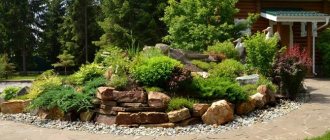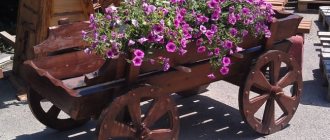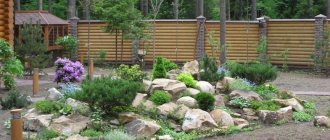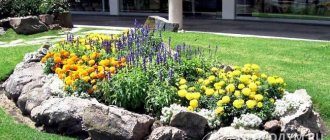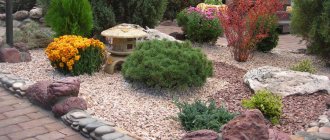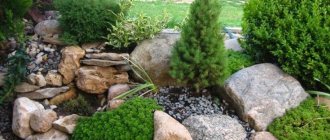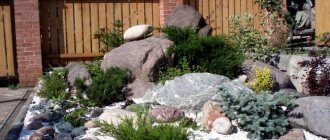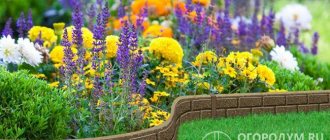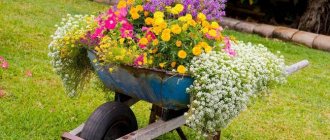To improve the area near a private house in an original style, they turn to landscape design. Many projects involve the use of natural stone not only for decoration, but also as a main element. For example, rock gardens, special flower beds, rock gardens, ponds and other decorative compositions will turn the exterior of any building into a landscape masterpiece.
When choosing the main natural material, not only its appearance and combination with other elements, but also a number of characteristics are taken into account. For example, for large areas it is appropriate to use large stones (boulders, cobblestones), for alpine slides a solid base is selected, and for the design of reservoirs, pebbles of different shapes, sizes and colors would be appropriate.
Types of stone flower beds
You can make the appearance of a flower bed out of stones at your discretion. Based on generally accepted principles, they all differ into 3 groups.
A rock garden (alpine slide) can be of different styles and sizes, but has one distinctive feature: the obligatory combination of mountain vegetation and stones. It can be collected due to natural elevation changes on the site or using bulk soil. Divided into several types:
Exterior view of the rocky hill Source yandex.ru
- Rocky hill. The stones are piled up like a kind of hill. The peak is crowned by a medium-sized fragment, reminiscent of the top of a mountain.
Terrace made of flat stones Source tinyfriendsanimalrescue.com
- Terrace. It is assembled from flat stones, most often flagstone is used for this. It is made of several tiers resembling steps.
Flagstone flowerbed Source domnomore.com
- Czech rolling pin. Just like in the terrace, flat flagstone is used. It is installed on an edge, forming an arrangement of mountain ridges. Everything between them is covered with soil to no more than half the height of the stone.
- Retaining wall. It is used as a skillfully decorated strengthening of the slope of the site.
A rockery is a kind of flowerbed in which stones predominate. Another name is “Stone Garden” or “Stone Flowerbed”. A distinctive feature from a rock garden is that first of all, attention is attracted by cobblestones and crushed stone bedding, and only after that the visual switch occurs to secondary details: greenery.
Original flower bed Source sheherazadenyc.com
- European. Planted with ground cover perennials characterized by abundant flowering: aubrietta, arabis, tenacious.
Flowerbed in Asian style Source mercabadom.ru
- Japanese. A large number of stones and a minimum of vegetation. Flowers are planted in rare places. It is better to use unpretentious herbs and grains: fescue, golden beard, reed grass.
Strict British flowerbed Source giropark.ru
- English. Its appearance is reminiscent of the vegetation of Foggy Albion with a predominance of coniferous, low-growing species: spruce, juniper, pine.
A flowerbed is a definition of a flower garden that we all understand from childhood, in which stone is used only as a frame. Characterized by appearance and structure, they are divided into 4 groups:
- Elated. Enclosed by a stone parapet. Can be of different heights: from 30 to 100 cm.
Important! To avoid spreading, use cement mortar.
See also: Catalog of companies that specialize in landscaping work on sites.
Several levels Source spainproject.ru
- Multi-level. It looks like a cascade consisting of several steps. Each tier acts as a separate flower bed.
Gabion design Source dacha-ogorod.com
- Gabion. A model assembled from a medium-sized stone placed in a metal frame. Configuration and height may vary.
- Border. The soil level in the flower garden remains at the same height or rises, but only slightly. The frame protrudes only 10-15 cm.
Material selection
It is allowed to use various rocks as the main material for arranging a flower bed. These can be natural stones, bricks left over from a construction site, or hand-poured concrete blocks of the required size.
Flowerbed in a small garden Source Ognezaschita
- The advantage of limestone and pebbles is that the rocks have a varied palette of shades: yellow, cream, gray, pink. They look good in combination with moss, algae, and near artificial reservoirs.
Flowerbed made of stone Source sk.facebook.com
- The disadvantage of using sandstone is that the rock is susceptible to destruction under the influence of wind and water. Despite this, due to the wide range of colors it is used everywhere.
Processed Volcanic Tuff Source sunvalleyvacationhomerentals.com
- Volcanic tuff is a durable but easily processed material. Has a wide range of shades. Looks great in flower beds planted with creeping and climbing plants.
Slate flower bed Source plotnikov-pub.ru
- Due to its layered structure, slate is often used to form raised flower beds. The ability to exfoliate into thin plates makes it very popular in landscape design.
Round flower bed made of granite Source hug-fu.com
- Granite, quartzite, basalt are some of the most durable stones used for arranging flower beds. Create a lasting impression in sunny areas. The visual effect is enhanced by the abundance of colors and smooth, shiny surface.
Important! Please note that granite can oxidize the soil. Therefore, the choice of plants for such a flower bed will be limited.
Original flower garden Source diabacorreview.com
- Brick, paving stones or other concrete products, due to their correct geometric shape, will serve to assemble a beautiful fence for a flower bed of any shape. The classic type of materials harmonizes well in flower beds of almost any configuration.
Consequently, any type of stone can be used to arrange a flower bed in a garden plot. It is enough to use a little imagination and the material at hand.
Types of decorative stone for flower beds Source idei-landshafta.ru
Size and shape matter
Landscape stones have the following classification:
- A block
is a stone up to 50 cm in diameter with faceted, sharp edges. - A boulder
is a rounded stone up to 50 cm in diameter. - Cobblestone
is a rounded stone up to 20-50 cm in diameter. Backfill (crushed stone) is a mass of crushed stones with sharp edges 5-10 cm in diameter. - Pebbles
are flat-rounded stones. Pebbles are divided by origin: river and sea. In industrial conditions, pebbles are made from granite, marble and quartzite. The size of the pebbles is determined using fractions. So, for example, pebbles of fraction 2-4 means that this stone mass will contain round stones from 2 to 4 cm in diameter. Pebbles of fraction 5-10 means that there will be stones from 5 to 10 cm in diameter. - Crumb
is the smallest form of crushed natural stone. Usually this is marble chips. - Flagstone
is slabs of natural stone of arbitrary shape that have approximately the same thickness. The thickness of the flagstone varies from 10 mm to 70 mm. - Rubble stones
are small rocks that are mined in quarries or in the mountains.
Any size can be used in landscape design. Boulders and cobblestones will harmoniously fit into an alpine hill, cobblestones will decorate flower beds and become the basis for a retaining wall, pebbles are suitable for creating a complete space for a recreation area.
Making a flowerbed out of stones: a clear step-by-step algorithm
The flowerbed fencing can be built in a single layer or by raising it over several rows of bricks. Depending on this, the installation method will also change: using a cement-sand mortar, without it, or assembling the walls with filling the cracks between the stones with ordinary soil.
Low-growing bushes in landscape design Source landshaftdizajn.ru/
Brick flowerbed
As an example, let's look at one of the simplest ways to make a flower bed - assembling it from brick. The work order is as follows:
DIY flowerbed in the garden Source raflon.ru
- Marking the site of the future flower bed is carried out using pegs and thread.
- A trench is dug along the intended trajectory, 20-30 cm deep.
- 10 cm of fine gravel and the same amount of sand are poured to the bottom.
- It is spilled with water, carefully compacted, leveled.
- For rigid adhesion of bricks, cement mortar is used, mixed in a ratio of 1 to 3.
Important! When arranging a flowerbed from the “Border” category, 1-2 rows high, the use of a cement-sand mixture can be eliminated. For taller people it is a must.
- The masonry is done according to the classical scheme, with the next row overlapping half of the bottom one. This will allow you to achieve better structural strength indicators.
- Periodically check the plane and angle of inclination with a building level.
- Backfilling with soil is carried out no earlier than one day after completion of work with the stone.
Flowerbed made of stone and cement
Laying flower beds from natural stone of non-standard sizes requires more careful attention and responsibility. This is done as follows:
- The fertile layer of soil is removed along the designated perimeter, depth: 20-30 cm.
- Sand and gravel filling is made. It is spilled with water, compacted, leveled.
- The stones are placed after careful sorting. Large ones go down, gradually decreasing as they rise.
Stone flowerbed around a tree Source twitter.com
- The boulders are moved repeatedly in order to achieve maximum contact with each other.
Filling joints with cement mortar occurs in one of two ways:
- The mixture is laid during the laying process. The seams between the stones remain clean, making them look more natural. The disadvantage is that water gets into the cracks and the likelihood of subsequent defrosting, which can lead to partial destruction of the flowerbed.
- Filling all seams and voids between stones. It is done on both sides. The mortar will be visible, but the masonry will be strong and will last much longer.
Coating with solution Source twitter.com
Almost finished result Source rukami.boltai.com
The filling of fertile soil is carried out no earlier than one day after the completion of the masonry.
Subtleties of work, secrets of a beautiful flower bed
The main secret to creating a beautiful flower bed made of stone is to adhere to several principles that are common to all options:
- The flower garden should please the eye. Place it in a visible place: near a wall or in the center of the garden.
- The choice of seedlings is determined based on microclimatic conditions. This is especially true for light-loving plant varieties.
- Pay attention to the size and flowering period of the plantings. Using annual flowers risks the fact that at a certain period of time your flowerbed may be empty.
- The appearance of the flower garden should be correctly combined with a single ensemble of the entire garden.
To lay a stone flower bed, one of several methods can be used, depending on the result that should be achieved:
Beautiful flower garden using stone Source one-stroy
- When arranging an alpine slide in the Czech rolling pin style, flat stones are placed in a vertical position. For the Terrace Garden - horizontal.
Flowerbed-rockery on the site Source forum-obscheniya
- A rockery does not necessarily imply the presence of sides. The only condition for laying stones here is their uniformity.
Gabion in the garden interior Source siegmundlandscape.com
- One of the most complex is the construction of gabions. For construction, you will need a metal frame into which stones belonging to the same breed are placed.
On the other hand, you can ignore all these conventions and organize a flower bed at your own discretion. It is enough to express your desire, use your imagination, and select suitable materials and vegetation.
Where to use the stone?
In the landscape business, there have long been many options for using stone to decorate areas. Almost any modern project cannot do without this kind of decor. So, with the help of stones they design:
- Paths, alleys, entrances to garages or parking spaces;
- Fountains, sides and decorative steps;
- Fences, enclosures, gazebos and arches;
- Slides, waterfalls, “stone streams”;
- Walls of a house, summer kitchen and other buildings;
- Flowerbeds
Of course, nothing limits your imagination here; stones can be used not only for decoration or cladding, but also as an independent element (or even the center) of a composition.
Thus, such projects are usually brought to life by creating a Japanese garden or a Japanese zone on the site, because it is in the culture of this country that raw stone plays a very important role, and for a garden it is simply necessary.
Raised garden bed made of stone and cement
Choosing this type of flower bed can be a stylish and practical solution for your garden at the same time. The key advantage is its design, which makes growing flowers possible in any soil. In addition, a raised flower bed can visually increase the area of a small area. Multi-level compositions will further enhance the visual effect.
DIY flower garden Source drive2.
Other advantages of a raised flower bed include:
- Protection against weeds and some pests. You won't have to bend down repeatedly while caring for plants.
- It becomes possible to grow rare varieties of flowers that require a special soil composition. For example, hydrangea and conifers, which prefer acidic soils.
Among the disadvantages you need to consider:
- Increasing frequency of watering - the soil at higher elevations dries out faster than below.
- Construction capital. Depending on what is planned, this may take more than one day.
Important! Proceed with arranging a raised flower bed only after you have weighed all the advantages and disadvantages.
Coniferous shrubs and trees as decorative elements for stone flower beds
Conifers in the garden interior Source Siegmundlandscape
Combination with coniferous plants will be an ideal option if you do not have time to tend to the flower bed every day. Evergreen shrubs are unpretentious and belong to the long-living category. There can be quite a few ways to decorate a flower garden.
The “Silver River” landscape stone flowerbed will act as an island mixborder or will advantageously stretch along the sidewalk. A composition of conifers interspersed with grasses will create a flowing look. It will delight throughout the entire season, almost until the snow.
Consists of the following plant species:
- Juniper scaly "Blue Сarpet".
- Juniper virginiana "Grey Owl".
- Prickly spruce "Glauca Globosa".
- Gray fescue.
- The carnation is grayish-blue.
"Flowerbed with Irises" prefers sunny places. The key form is 2 types of conifers that can maintain their color throughout the year. Irises of any shade look harmonious in the center. Along the edges are plantings of pink spirea resembling lanterns. The composition is easy to maintain and has an original appearance, which allows you to place it near the entrance gate or gazebo.
Design option with old buckets Source landshaftportal.ru/
Consists of the following plant species:
- Thuja occidentalis "Globosa".
- Cypress pea fruit.
- Spiraea Boumalda "Froebelli".
- Juniper scaly "Blue Сarpet".
- Iris hybrid.
When arranging a coniferous flower bed made of stone, pay attention to the individual principles of landscape design inherent to this group. They are as follows:
Flowerbed with evergreens Source yandex.ru
- Proportionality is mandatory. Large coniferous mixborders are located at a distance from buildings, fences and other areas of your garden. This is necessary due to the volume of plants that comes with age.
Pay attention to the cardinal directions Source pinterest.ch
- Place the flower bed with evergreens in an east or west direction. This way the plants will receive the right amount of sun, which will have a beneficial effect on development.
Two tiers of flower beds Source laidbackgardener.blog
- Calculate zone planting so that there is at least 1 m2 of area per coniferous plant. This reserve will compensate for slow growth and will allow the remaining space to be filled with annual grasses.
Bright spot of landscape design Source remoo.ru/
Phosphorescent stone
The category is completely special. In the light they are no different from other decorative elements and are completely invisible, but at night you will notice a bright glow.
That is why it is worth using it to completely pave paths or simply decorate the border. Also, luminous stones for the garden and landscape are suitable for the sides of pools, ponds and fountains.
